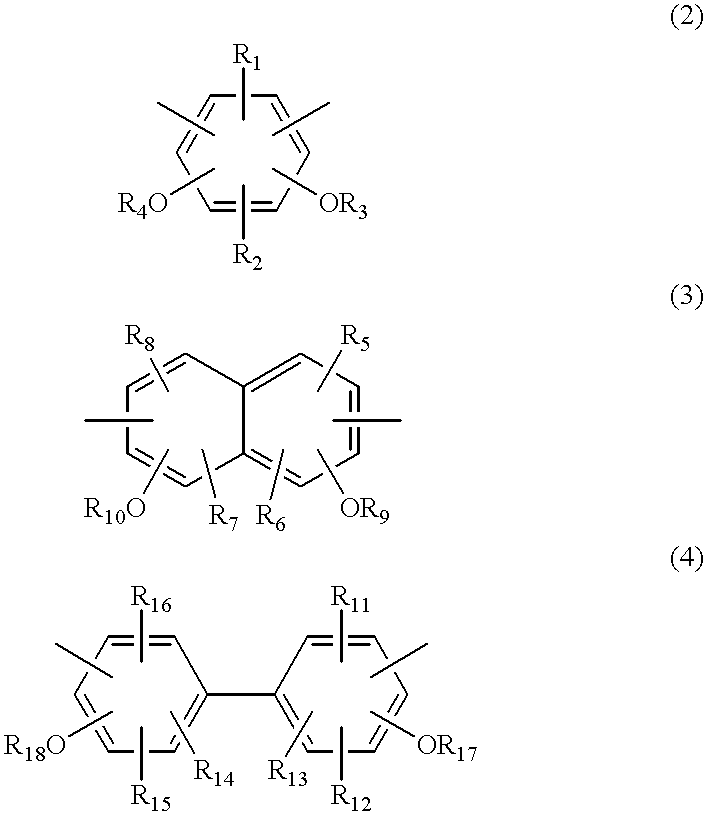Polybenzoxazole resin and precursor thereof
a technology of polybenzoxazole and precursors, applied in the field of polybenzoxazole resins and precursors thereof, can solve the problems of dielectric constant, properties have not yet reached the desired level, and two characteristics are hardly compatible with each other, and achieve excellent electric characteristics and heat resistance.
- Summary
- Abstract
- Description
- Claims
- Application Information
AI Technical Summary
Benefits of technology
Problems solved by technology
Method used
Image
Examples
preparation example 2
19.6 Grams of 2,2'-bistrifluoromethyl-4,4'-biphenylenedicarboxylic acid chloride was obtained in the same manner as in Preparation Example 1, except that 24.1 g of 2,2'-bistrifluoromethyl-4,4'-biphenylenedicarboxylic acid was used in place of 25.0 g of 4,4'-hexafluoroisopropylidenediphenyl-1,1'-dicarboxylic acid used in Preparation Example 1.
preparation example 3
50 Grams of 1,2,3,5-tetrafluoro-4,6-dicyanobenzene was added to 250 g of 65% aqueous sulfuric acid. The former was dissolved by heating, and then the solution was heated for 3 hours under refluxing conditions. The precipitated crystal was subjected to suction filtration, and the collected crystal was washed with concentrated hydrochloric acid and then air-dried to obtain 35.8 g of tetrafluoroisophthalic acid.
15.0 Grams of tetrafluoroisoisophthalic acid, 45 ml of thionyl chloride and 0.5 ml of dried DMF were charged in a reaction vessel, and their reaction was carried out at 60.degree. C. for 2 hours in a nitrogen atmosphere. After completion of the reaction, the excess thionyl chloride was distilled off by heating under reduced pressure. The residue was subjected to distillation under reduced pressure to obtain 11.4 g of tetrafluoroisophthalic acid chloride.
Examples of Polybenzoxazole Precursors and Polybenzoxazole Resins
example 1
9.04 Grams (0.02 mol) of 4,4'-diamino-3,3'-dihydroxy-5,5'-dipentafluoroethylbiphenyl was charged in a separable flask equipped with a stirrer, a nitrogen introducing pipe and a dropping funnel, and dissolved in 100 g of dried N-methylpyrrolidone (hereinafter referred to as "NMP").
Then, 3.96 g (0.05 mol) of dried pyridine was added to the solution, followed by adding dropwise thereto a solution comprising 8.58 g (0.02 mol) of 4,4'-hexafluoroisopropylidenediphenyl-1,1'-dicarboxylic acid chloride obtained in Preparation Example 1 and 50 g of dried NMP at 5.degree. C. over 60 minutes. After completion of the addition, the temperature of the reaction mixture was restored to room temperature, followed by stirring the reaction mixture as it was for 5 hours. After completion of the reaction, the reaction mixture was added dropwise to 1500 ml of a solution comprising water and ethanol at 1:1, and the precipitate was collected and dried to obtain a polybenzoxazole precursor.
The resultant poly...
PUM
| Property | Measurement | Unit |
|---|---|---|
| Structure | aaaaa | aaaaa |
Abstract
Description
Claims
Application Information
 Login to View More
Login to View More - R&D
- Intellectual Property
- Life Sciences
- Materials
- Tech Scout
- Unparalleled Data Quality
- Higher Quality Content
- 60% Fewer Hallucinations
Browse by: Latest US Patents, China's latest patents, Technical Efficacy Thesaurus, Application Domain, Technology Topic, Popular Technical Reports.
© 2025 PatSnap. All rights reserved.Legal|Privacy policy|Modern Slavery Act Transparency Statement|Sitemap|About US| Contact US: help@patsnap.com



